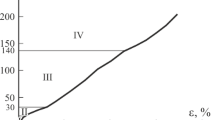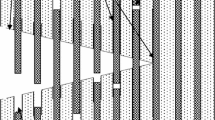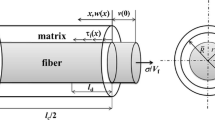The uniaxial tensile behavior of unidirectional C/SiC ceramic-matrix composites at room temperature has been investigated. An approach to predicting the uniaxial tensile stress–strain curve of the unidirectional ceramicmatrix composites is developed. The Budiansky–Hutchinson–Evans shear lag model is used to describe the microstress field of damaged composites. A statistical matrix cracking model, a fracture mechanics interface debonding criterion, and a statistical fiber failure model are used to determine the spacing of matrix cracks, the debonded length of interface, and the volume fraction of failed fibers. By combining the shear lag model and the three damage models, the stress–strain curve at each damage stage is constructed and an exact method for predicting the toughness and strength of the composites is established. The tensile stress–strain curves predicted by the present analysis agree well with experimental data.







Similar content being viewed by others
References
R. Naslain, “Design, preparation and properties of non-oxide CMCs for application in engines and nuclear reactors: an overview,” Compos. Sci. Technol., 64, No.2, 155-170 (2004).
F. S. Ji and L. R. Dharani, “Non-axisymmetric matrix cracking and interface debonding with friction in ceramic composites,” Appl. Compos. Mater., 5, No. 6, 379-397 (1998).
W. A. Curtin, “Stress–strain behavior of brittle matrix composites, Comprehensive composite materials,” Elsevier Sci. Ltd. 4:47-76 (2000).
L. B. Li and Y. D. Song, “An approach to estimate interface shear stress of ceramic matrix composites from hysteresis loops,” Appl. Compos. Mater., 17, No. 3, 309-328 (2010).
L. B. Li, Y. D. Song, and Z. G. Sun, “Influence of fiber Poisson contraction on matrix cracking development of ceramic matrix composites,” J. of Aerospace Power, 23, No. 12, 2196-2201 (2008). (in Chinese)
L. B. Li, Y. D. Song, and Z. G. Sun, “Uniaxial tensile behavior of unidirectional fiber reinforced ceramic matrix composites,” Acta Materiae Compositae Sinica, 25, No. 4, 154-160 (2008). (in Chinese)
B. Budiansky, J. W. Hutchinson, and A. G. Evans, “Matrix fracture in fiber-reinforced ceramics,” J. Mech. Phys. And Solids, 34, No. 2, 167-189 (1986).
I. M. Daniel and J. W. Lee, “The behavior of ceramic matrix fiber composites under longitudinal loading,” Compos. Sci. Technol., 46, No. 2, 105-113 (1993).
J. Aveston, G. A. Cooper, and A. Kelly, “Single and multiple fracture,” Properties of fiber composites: Conf. on Proceedings. England: National Physical Laboratory, IPC. 15-26 (1971).
F. W. Zok and S. M. Spearing, “Matrix crack spacing in brittle matrix composites,” Acta Metallurgica et Materialia, 40, No. 8, 2033-2043 (1992).
H. Zhu and Y. Weitsman, “The progression of failure mechanisms in unidirectional reinforced ceramic composites,” J. Mech. Phys. of Solids, 42, No. 10, 1601-1632 (1994).
J. P. Solti, S. Mall, and D. D. Robertson, “Modeling damage in unidirectional ceramic-matrix composites,” Compos. Sci. Technol., 54, No.1, 55-66 (1995).
W. A. Curtin, “Multiple matrix cracking in brittle matrix composites,” Acta Metallurgica et Materialia, 41, No. 5, 1369-77 (1993).
C. H. Hsueh, “Crack-wake interface debonding criterion for fiber-reinforced ceramic composites,” Acta Materialia, 44, No. 6, 2211-2216 (1996).
Y. C. Gao, Y. W. Mai, and B. Cotterell, “Fracture of fiber-reinforced materials,” Zeitschrift für Angewandte Mathematik und Physik (ZAMP), 39, No.4, 550-572 (1988).
Y. J. Sun and R. N. Singh, “The generation of multiple matrix cracking and fiber-matrix interfacial debonding in a glass composite,” Acta Materialia, 46, No. 5, 1657-1667 (1998).
M. D. Thouless and A. G. Evans, “Effects of pull-out on the mechanical properties of ceramic matrix composites,” Acta Metallurgica, 36, No. 3, 517-522 (1988).
H. C. Cao and M. D. Thouless, “Tensile tests of ceramic-matrix composites: theory and experiment,” J. of the American Ceramic Society, 73, No.7, 2091-2094 (1990).
M. Sutcu, “Weibull statistics applied to fiber failure in ceramic composites and work of fracture,” Acta Metallurgica, 37, No. 2, 651-661 (1989).
H. R. Schwietert and P. S. Steif, “A theory for the ultimate strength of a brittle-matrix composite,” J. of the Mechanics Physics of Solids, 38, No. 3, 325-343 (1990).
W. A. Curtin, “Theory of mechanical properties of ceramic-matrix composites,” J. of the American Ceramic Society, 74, No.11, 2837-2845 (1991).
Y. Weitsman and H. Zhu, “Multi-fracture of ceramic composites,” J. of the Mechanics Physics of Solids, 41, No. 2, 351-388 (1993).
F. Hild, J. M. Domergue, F. A. Leckie, A. G. Evans, “Tensile and flexural ultimate strength of fiber-reinforced ceramicmatrix composites,” Int. J. of Solids and Structures, 31, No. 7, 1035-1045 (1994).
H. Zhu and Y. Weitsman, “The progression of failure mechanisms in unidirectional reinforced ceramic composites,” J. of Mechanics Physics of Solids, 42, No.10, 1601-1632 (1994).
W. A. Curtin, B. K. Ahn, and N. Takeda, “Modeling brittle and tough stress-strain behavior in unidirectional ceramic matrix composites,” Acta Materialia, 46, No. 10, 3409-3420 (1998).
R. Paar, J.-L.Valles, and R. Danzer, “Influence of fiber properties on the mechanical behavior of unidirectionallyreinforced ceramic matrix composites,” Mater. Sci. and Eng.: A, 250, No. 2, 209-216 (1998).
K. Liao and K. L. Reifsnider, “A tensile strength model for unidirectional fiber-reinforced brittle matrix composite,” Int. J. of Fracture, 106, No. 2, 95-115 (2000).
S. J. Zhou and W. A. Curtin, “Failure of fiber composites: a lattice green function model,” Acta Metallurgica et Materialia, 43, No. 8, 3093-3104 (1995).
R. E. Dutton, N. J. Pagano, and R. Y. Kim, “Modeling the ultimate tensile strength of unidirectional glass-matrix composites,” J. of the American Ceramic Society, 83, No. 1, 166-174 (2000).
Z. **a and W.A. Curtin, “Toughness-to-brittle transitions in ceramic-matrix composites with increasing interfacial shear stress,” Acta Materialia, 48, No. 20, 4879-4892 (2000).
N. Ramakrishnan and V. S. Arunachalam, “Effective elastic moduli of porous ceramic materials,” J. of the American Ceramic Society, 76, No. 11, 2745-2752 (1993).
W. A. Curtin, “In situ fiber strengths in ceramic-matrix composites from fracture mirrors,” J. of the American Ceramic Society, 77, No. 4, 1075-1078 (1994).
A. W. Pryce and P. A. Smith, “Matrix cracking in unidirectional ceramic matrix composites under quasi-static and cyclic loading,” Acta Metallurgica et Materialia, 41, No. 4, 1269-1281 (1993).
D. S. Beyerle, S. M. Spearing, F. W. Zok, and A. G. Evans, “Damage and failure in unidirectional ceramic matrix composites,” J. of the American Ceramic Society, 75, No. 10, 2719-25 (1992).
B. F. Sørensen and J. W. Holmes, “Effect of loading rate on the monotonic tensile behavior of a continuous-fiberreinforced glass-ceramic matrix composite,” J. of the American Ceramic Society, 79, No. 2, 313-320 (1996).
T. Okabe, J. Komotori, M. Shimizu, and N. Takeda, “Mechanical behavior of SiC fiber reinforced brittle-matrix composites,” J. of Material Science, 34, No. 14, 3405-3412 (1999).
Acknowledgements
This work was sponsored by the Postdoctoral Science Foundation of China (Grant No. 2012M511274) and the Introduction of Talents Scientific Research Foundation of Nan**g University of Aeronautics and Astronautics (Grant No. 56YAH12034). The authors also thank the anonymous reviewers and the editor for their valuable comments.
Author information
Authors and Affiliations
Corresponding author
Additional information
Russian translation published in Mekhanika Kompozitnykh Materialov, Vol. 49, No. 6, pp. 985-1004, November-December, 2013.
Rights and permissions
About this article
Cite this article
Li, L.B., Song, Y.D. & Sun, Y.C. Modeling the Tensile Behavior of Unidirectional C/SiC Ceramic-Matrix Composites. Mech Compos Mater 49, 659–672 (2014). https://doi.org/10.1007/s11029-013-9382-y
Received:
Revised:
Published:
Issue Date:
DOI: https://doi.org/10.1007/s11029-013-9382-y




